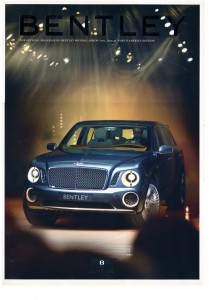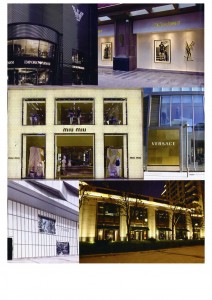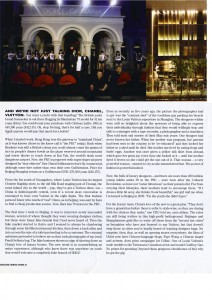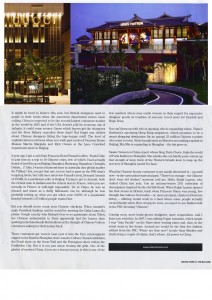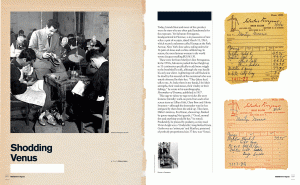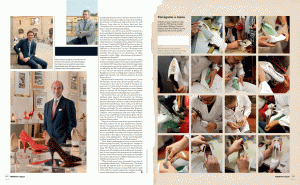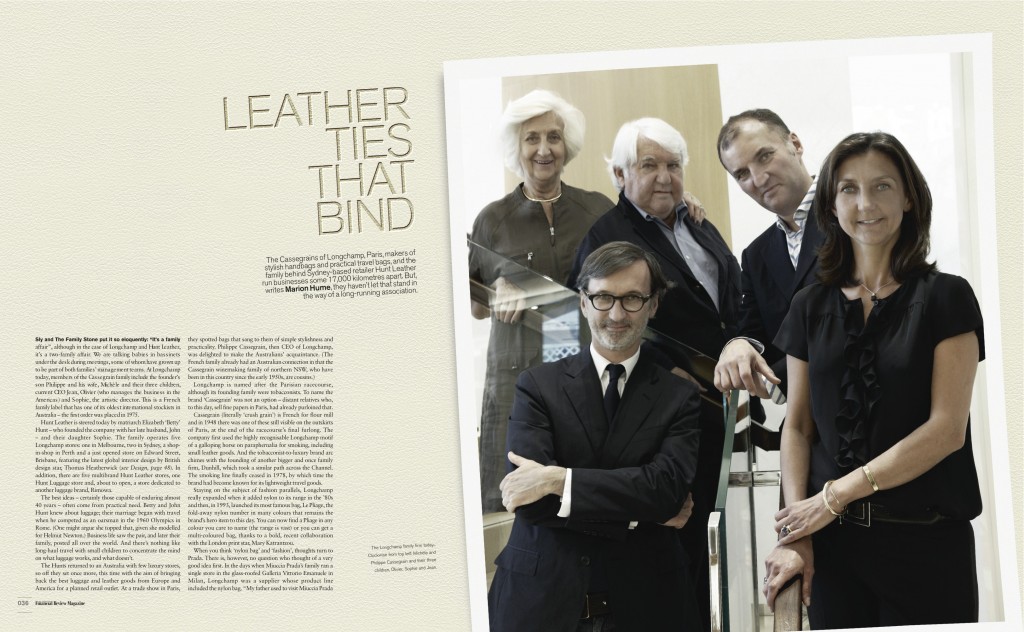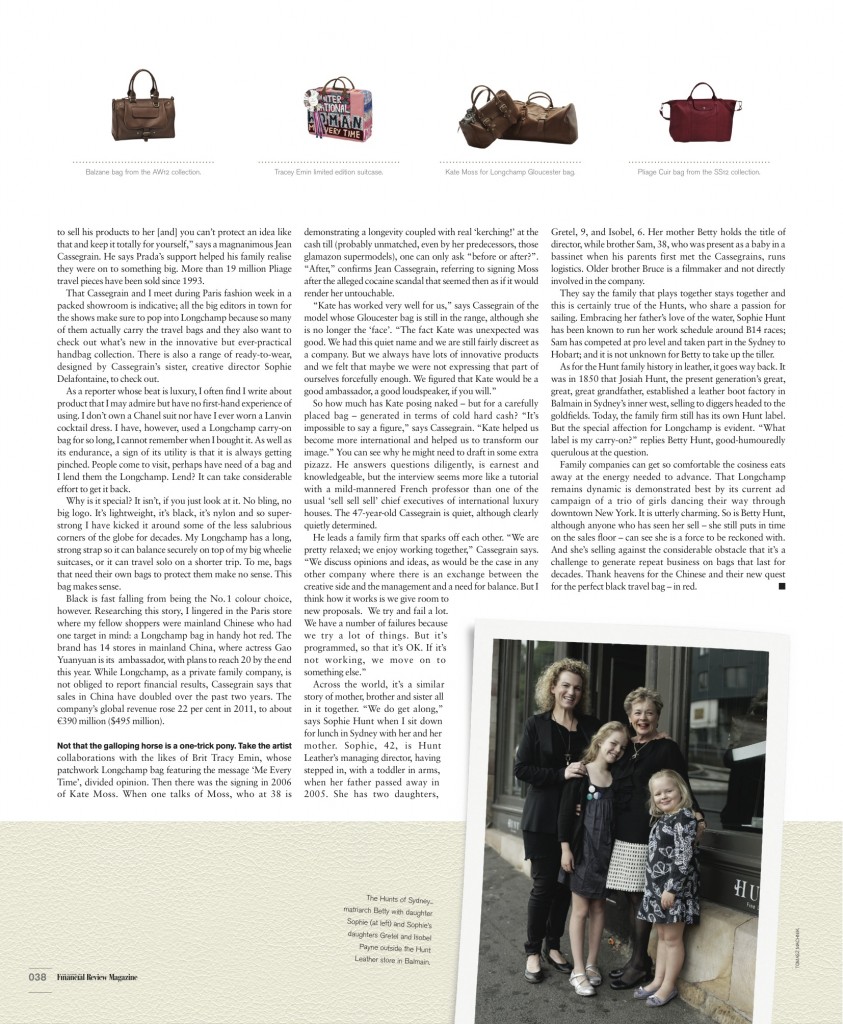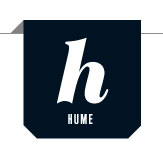Ferragamo and Screen Goddesses: a Perfect Fit – Australian Financial Review
Shodding Venus
When it comes to celebrity endorsement, you can’t top Marilyn Monroe. The story behind master shoemaker Salvatore Ferragamo, his muses and the legacy.
The Australian Financial Review Magazine | August 2012
by Marion Hume
Today, brands bleat and tweet of free product worn by stars who are often paid handsomely for the exposure. Yet Salvatore Ferragamo, headquartered in Florence, is in possession of rare relics: a pair of receipts, dated March 11, 1961, which record a salesman called George at the Park Avenue, New York shoe salon, taking orders for 16 pairs of shoes and a white calfskin bag. In return, the most famous woman in the world wrote cheques totalling $US563.30.
These were far from Marilyn’s first Ferragamos. In the 1950s, Salvatore pushed his heel height up to 11 centimetres specifically to add more wiggle to the bombshell’s walk, although she was hardly his only star client. A glittering role call flocked to be shod by this messiah of the metatarsal who was utterly obsessed by their feet. “They [these feet] talk to me. As I take them in my hands, I feel their strengths, their weaknesses, their vitality or their failings,” he wrote in his autobiography, Shoemaker of Dreams, published in 1957.
This rags-to-riches-to-rags-to-riches life story features (literally) walk-on parts from such silver screen icons as Lillian Gish, Clara Bow and Gloria Swanson – although the shoemaker was far less intrigued by them from the ankle up. Then later, Hitler’s mistress, Eva Braun, showed up, flanked by goose-stepping Nazi guards. (“Good, normal feet and anything would fit her,” he noted). Predictably, he praised by podiatry, so tiny-toed Vivien Leigh was a ‘Cinderella’, longlimbed Greta Garbo was an ‘aristocrat’ and Marilyn, possessed of perfectly proportioned size 37 feet, was ‘Venus’.
It is 50 years since the avatar of the American dream died. Yet a master craftsman called Stefano Frasconi is holding a pump in soft white lambskin, a near replica of the one Marilyn ordered many times – in white, nude, black, gold. As Frasconi holds a shoe that is yet to meet its heel, he is struggling to explain – through a translator and a mouthful of nails – what makes it special. But just like the company founder, any celebrity connection seems to be a sideline to him. Instead, Frasconi repeats “calzata perfectamente” (perfect fit), emphasising with sharp taps of a little hammer. He keeps pulling at the leather, pre-soaked for days to provide flexibility, then jumps up and puts the shoe in a customised oven, before stretching its leather upper again and banging it with the hammer.
In close-up, this scene, playing out at the Ferragamo atelier on the outskirts of Florence, may seem somewhat anachronistic: the shoemaker hunched over a low bench spread with tools not dissimilar to those Salvatore himself might have used when he started making shoes commercially in 1906, aged 13. (He had made his first shoes, for his sisters, when he was only nine). But luddite practices, however charming, don’t account for a company that is listed on the Milan stock exchange and has 593 stores worldwide. The organisation posted total revenues for the first quarter of 2012 of €259.6 million ($305.5 million). WHile skills of human eye and hand helped, state-of-the-art machines aided the production of hundreds of thousands of pairs of shoes, as well as clothing, luggage, small leather goods, eyewear, scarves, ties, timepieces, fragrance and handbags, made elsewhere in Italy.
Widening the focus reveals our location to be a vast, slick, industrial set-up known as Manovia, after the Italian word for circular ‘rail’ system, which here moves shoes from one production process to the next. Yet this, too, traces directly back to the founder, whose experiment with a mechanised production line that would still preserve the exacting standards of custom-made shoes was so ahead of its time, it lead to his 1933 bankruptcy.
Salvatore certainly bounded back. By the 1940s, the peasant boy from a family that had struggles for survival on a small holding was the proud owner both if Il Palagio, a sumptuous hillside villa outside FLorence that is still a family home, and a castle, complete with ramparts, right in the heart of the renaissance city. Palazzo Feroni remains the company’s headquarters. When Salvatore died suddenly in 1960, he left a much younger wife, Wanda, six children and a truly international business. Since then, it is the 90-year-old matriarch, ‘Mrs Wanada’, who still turns up for work every morning and who has preserved his legacy.
To avoid confusion, it is Ferragamo company policy to call family members by their first name, preceded by ‘Mr’ or ‘Mrs’. Hence the 67-year-old Ferruccio, who is chairman of the company, is dubbed Mr Ferruccio. His siblings – Mrs Giovanna, Mrs Fulvia, Mr Leonardo and Mr Massimo – all have key roles. (The eldest daughter, Fiamma, who designed the best-selling flat Vara pump with its gold plaque and grosgrain ribbon, dies in 1998).
Given there are 60 direct heirs, not only is there no room at the family firm for them all but a wise and stringent charter decrees that only the top three from each subsequent generation are welcome. The most visible of the third generation,in part because of his matinee idol looks, is 40-year-old Mr James, who is women’s leather product director. The first of the fourth generation to hit 21, Lorenza Gentile, has not yet fulfilled the minimum requirements even to apply: an MBA and several years experience work elsewhere.
When Mr Ferruccio sits down to chat over a rocket-fuel espresso at the palazzo, he says that what locks everything together is “quality products that are good value for what they are; with innovation, long-lasting”. This sounds much like many other brands, but he adds that the difference is: “We don’t want to ever overcome the personality of the customer.” Evidence can be found directly below us, in the mirrored shoe salon at street level. The Viatica is a timeless two-tone stiletto of white suede and black calf. That Marilyn Monroe’s ‘Sugar’ Kane Kowalczyk wore this exact style to woo her Shell Oil millionaire in Some Like it Hot starts to matter note more but, strangely, less, once these lovely shoes are beckoning one’s own feet. Which is to say, you yearn for them to be yours, not hers.
What lies beneath remains the same, then and now. The soul of Ferragamo – pun intended- is the sole. The founder- who lied in Italy, then America, then returned to Italy – was studying anatomy at night school in Los Angeles just as architects on Americana’s east coast were realising that they could build skyscrapers taller with less load-bearing structure at the base. Similarly, Salvatore surmised that, as the weight of the erect human body is borne not by toes or heels but drops straight down on the arch, a revolutionary steel arch support would act with the equilibrium of the body in motion instead of fighting against it. This slim plate remains central to comfort. No wonder that (whisper it) both the queen of the red carpet, Angelina Jolie, and the queen of all she surveys, HRH Elizabeth II, are believed to be loyal, paying customers.
That Ferragamo also offers a wide range of fittings (A to D, others on special order) has helped gather fans in the brand’s most robust market, China. There widths C and D are hte most common, which has ripped up other luxury shoemakers offering styles of a narrow French foot and who may also have faced an additional anatomical barrier: purveyors of very high-heeled ‘limo shoes’ find these cannot adapt to the average length of the chinese foot without the wearer being en point like a ballerina. That said, Chinese movie star, Fan Bingbing does favour towering Ferragamos. THese are custom-made, their height achieved with extraordinary platforms. As for Australian feet, Salvatore has this to say about them when he visited Sydney in 1958: “Nature has been generous in length though they, too, are narrow.”
The Asia Pacific region is the group’s top market in terms of revenue, up 27.3 per cent with a turnover of 96.4million for the first quarter of 2012. A further reason is menswear, attractive to a market where men tend to embrace luxury goods before they treat their wives. For Salvatore Ferragamo himself it was making books for men that led to his breakthrough American success. Salvatore made his mark in the American motion picture industry, before i relocated from Santa Barbara to Hollywood, with cowboy boots for early Westerns. From then on, he always shod male feet. (“Mussolini lost his corns and bad toenails after he wore my boots,” is just one comment n the subject).
The founder’s sons, Mr Ferruccio and Mr Leonardo, first stood on the Bund in Shanghao when they past was mud their feet. The brand debuted with a store in the city in 1994 (with local partner, Imaginex). Hermès, Chanel, Prada, Gucci are between two and six times bigger than Ferragamo, yet in China this pioneer consistently marches ahead and is present in 34 cities. Company CEO Michele Norsa has no fears of brand saturation in China. “Not at all, we worked with McKinsey on a fiveyear plan,” he says. “We imagine in the next three to five years, we can cover another 10 to 20 cities probably. The potential of new destinations in China connected by trains, flights, infrastructure development is becoming very substantial.”
Norsa – known by his surname because he is an outsider, the first non-family member to hold a keymanagerial position – was hired in 2007, primarily to put in place the organisation and governance to gear up the company for an IPO, which was delayed by the 2008 crash and accomplished successfully last year. He says that Chinese customers in Beijing and Shanghaimay travel to avoid high duties and taxes,which has helped make Australia “one of the best markets in the world this year for us”.
The shoesmust bemade in Italy, “one of our pluses”, insists Mr Ferruccio, “for the name, the best quality and also, as commitment to those who have worked at Ferragamo for many years.” As to his nation’s economic woes, the company chairman adds: “I am sorry because there are many elements which are uncertain. We are fortunate because we produce 100 per cent in Italy, butwe sell, I think, 9 per cent in Italy.”
The founder’s three sons and the next generation have significant other interests. Mr Ferruccio’s son Salvatore Ferragamo II, twin of Mr James, helms their father’s parallel hotel and wine business, based in a medieval hamlet about 45 minutes’ drive from Florence. Closer to Siena is an 800year old winery and hotel, Castiglion del Bosco, owned by Mr Massimo and family. The most ambitious other business is surely Mr Leonardo’s.He is chairman and owner of Lungarno Collection, a luxury hotel group, with seven of the swankiest places to stay around Florence and another in Rome. He also owns the majority of Nautor’s Swan, the largest global producer of luxury yachts.
Today, the core business is ring-fenced against hostile threats like those endured by the part family-owned Hermès. Salvatore Ferragamo SpA is ripe for further growth (Norsa cites Jakarta and Berlin as examples) and a dynasty’s long view means thatMr James has been able to continue the inventiveness of a grandfather who tried sweet wrappers, fishing wire and tree bark as shoe uppers. He innovates in a sustainable context, while admitting that a 100 per cent biodegradable handbag (nometal parts) has yet to find broad appeal.
“In my father’s autobiography, in a way you can tell he felt his life was going to be short,” says Mr Ferruccio. “Perhaps we have tried to accomplish what he wanted to do”. But let’s not forget Mrs Wanda, born just four years before Marilyn Monroe and still standing ramrod straight in her Ferragamo heels. It is the matriarch who greets guests for cocktails after they have visited Museo Salvatore Ferragamo, housed within the cavernous palazzo for an exhibition dedicated to the icon (Marilyn runs to January 28, 2013).
“When Daddy passed away, [my mother] knew how to make children but not shoes,”Mr Ferruccio says. “Yet she has lived her life with the desire of continuing the business”.
Indeed, Mrs Wanda, long ago a teenage bride, deserves much of the credit for a sometimes glamorous, sometimes gruelling journey of this brand born of a fascination with feet.
Leather Ties That Bind – Australian Financial Review
Leather Ties That Bind
The Cassegrains of Longchamp, Paris, makers of stylish handbags and practical travel bags, and the family behind Sydney based retailer Hunt Leather run businesses some 17,000 kilometres apart. But, writes Marion Hume, they haven’t let that stand in the way of a long running association.
The Australian Financial Review | September 2012
by Marion Hume
Sly and The Family Stone put it so eloquently: “It’s a family affair”, although in the case of Longchamp and Hunt Leather, it’s a two family affair. We are talking babies in bassinets under the desk during meetings, some of whom have grown up to be part of both families’ management teams. At Longchamp today, members of the Cassegrain family include the founder’s son Philippe and his wife, Michèle and their three children, current CEO Jean, Olivier (who manages the business in the Americas) and Sophie, the artistic director. This is a French family label that has one of its oldest international stockists in Australia – the first order was placed in 1975.
Hunt Leather is steered today by matriarch Elizabeth ‘Betty’ Hunt– who founded the company with her late husband, John – and their daughter Sophie. The family operates five Longchamp stores: one in Melbourne, two in Sydney, a shop in shop in Perth and a just opened store on Edward Street, Brisbane, featuring the latest global interior design by British design star, Thomas Heatherwick. In addition, there are five multibrand Hunt Leather stores, one Hunt Luggage store and, about to open, a store dedicated to another luggage brand, Rimowa.
The best ideas – certainly those capable of enduring almost 40 years – often come from practical need. Betty and John Hunt knew about luggage; their marriage began with travel when he competed as an oarsman in the 1960 Olympics in Rome. (One might argue she topped that, given she modelled for Helmut Newton.) Business life saw the pair, and later their family, posted all over the world. And there’s nothing like longhaul travel with small children to concentrate the mind on what luggage works, and what doesn’t.
The Hunts returned to an Australia with few luxury stores, so off they set once more, this time with the aim of bringing back the best luggage and leather goods from Europe and America for a planned retail outlet. At a trade show in Paris, they spotted bags that sang to them of simple stylishness and practicality. Philippe Cassegrain, then CEO of Longchamp, was delighted to make the Australians’ acquaintance. (The French family already had an Australian connection in that the Cassegrain winemaking family of northern NSW, who have been in this country since the early 1950s, are cousins.)
Longchamp is named after the Parisian racecourse, although its founding family were tobacconists. To name the brand ‘Cassegrain’ was not an option – distant relatives who, to this day, sell fine papers in Paris, had already purloined that. Cassegrain (literally ‘crush grain’) is French for flour mill and in 1948 there was one of these still visible on the outskirts of Paris, at the end of the racecourse’s final furlong. The company first used the highly recognisable Longchamp motif of a galloping horse on paraphernalia for smoking, including small leather goods. And the tobacconist to luxury brand arc chimes with the founding of another bigger and once family firm, Dunhill, which took a similar path across the Channel.
The smoking line finally ceased in 1978, by which time the brand had become known for its lightweight travel goods. Staying on the subject of fashion parallels, Longchamp really expanded when it added nylon to its range in the ’80s and then, in 1993, launched its most famous bag, Le Pliage, the foldaway nylon number in many colours that remains the brand’s hero item to this day. You can now find a Pliage in any colour you care to name (the range is vast) or you can get a multicoloured bag, thanks to a bold, recent collaboration with the London print star, Mary Katrantzou.
When you think ‘nylon bag’ and ‘fashion’, thoughts turn to Prada. There is, however, no question who thought of a very good idea first. In the days when Miuccia Prada’s family ran a single store in the glassroofed Galleria Vittorio Emanuele in Milan, Longchamp was a supplier whose product line included the nylon bag. “My father used to visit Miuccia Prada to sell his products to her [and] you can’t protect an idea like that and keep it totally for yourself,” says a magnanimous Jean Cassegrain. He says Prada’s support helped his family realise they were on to something big. More than 19 million Pliage travel pieces have been sold since 1993.
That Cassegrain and I meet during Paris fashion week in a packed showroom is indicative; all the big editors in town for the shows make sure to pop into Longchamp because so many of them actually carry the travel bags and they also want to check out what’s new in the innovative but ever practical handbag collection. There is also a range of ready to wear, designed by Cassegrain’s sister, creative director Sophie Delafontaine, to check out.
As a reporter whose beat is luxury, I often find I write about product that I may admire but have no first hand experience of using. I don’t own a Chanel suit nor have I ever worn a Lanvin cocktail dress. I have, however, used a Longchamp carry on bag for so long, I cannot remember when I bought it. As well as its endurance, a sign of its utility is that it is always getting pinched. People come to visit, perhaps have need of a bag and I lend them the Longchamp. Lend? It can take considerable effort to get it back.
Why is it special? It isn’t, if you just look at it. No bling, no big logo. It’s lightweight, it’s black, it’s nylon and so super strong I have kicked it around some of the less salubrious corners of the globe for decades. My Longchamp has a long, strong strap so it can balance securely on top of my big wheelie suitcases, or it can travel solo on a shorter trip. To me, bags that need their own bags to protect them make no sense. This bag makes sense.
Black is fast falling from being the No.1 colour choice, however. Researching this story, I lingered in the Paris store where my fellow shoppers were mainland Chinese who had one target in mind: a Longchamp bag in handy hot red. The brand has 14 stores in mainland China, where actress Gao Yuanyuanis its ambassador, with plans to reach 20 by the end this year. While Longchamp, as a private family company, is not obliged to report financial results, Cassegrain says that sales in China have doubled over the past two years. The company’s global revenue rose 22 per cent in 2011, to about €390 million ($495 million).
Not that the galloping horse is a onetrick pony. Take the artist collaborations with the likes of Brit Tracy Emin, whose patchwork Longchamp bag featuring the message ‘Me Every Time’, divided opinion. Then there was the signing in 2006 of Kate Moss. When one talks of Moss, who at 38 is demonstrating a longevity coupled with real ‘kerching!’ at the cash till (probably unmatched, even by her predecessors, those glamazon supermodels), one can only ask “before or after?”. “After,” confirms Jean Cassegrain, referring to signing Moss after the alleged cocaine scandalthat seemed then as if it would render her untouchable.
“Kate has worked very well for us,” says Cassegrain of the model whose Gloucester bag is still in the range, although she is no longer the ‘face’. “The fact Kate was unexpected was good. We had this quiet name and we are still fairly discreet as a company. But we always have lots of innovative products and we felt that maybe we were not expressing that part of ourselves forcefully enough. We figured that Kate would be a good ambassador, a good loudspeaker, if you will.”
So how much has Kate posing naked – but for a carefully placed bag – generated in terms of cold hard cash? “It’s impossible to say a figure,” says Cassegrain. “Kate helped us become more international and helped us to transform our image.” You can see why he might need to draft in some extra pizazz. He answers questions diligently, is earnest and knowledgeable, but the interview seems more like a tutorial with a mildmannered French professor than one of the usual ‘sell sell sell’ chief executives of international luxury houses. The 47 year old Cassegrain is quiet, although clearly quietly determined.
He leads a family firm that sparks off each other. “We are pretty relaxed; we enjoy working together,” Cassegrain says. “We discuss opinions and ideas, as would be the case in any other company where there is an exchange between the creative side and the management and a need for balance. But I think how it works is we give room to new proposals. We try and fail a lot. We have a number of failures because we try a lot of things. But it’s programmed, so that it’s OK. If it’s not working, we move on to something else.”
Across the world, it’s a similar story of mother, brother and sister all in it together. “We do get along,” says Sophie Hunt when I sit down for lunch in Sydney with her and her mother. Sophie, 42, is Hunt Leather’s managing director, having stepped in, with a toddler in arms, when her father passed away in 2005. She has two daughters, Gretel, 9, and Isobel, 6. Her mother Betty holds the title of director, while brother Sam, 38, who was present as a baby in a bassinet when his parents first met the Cassegrains, runs logistics. Older brother Bruce is a filmmaker and not directly involved in the company.
They say the family that plays together stays together and this is certainly true of the Hunts, who share a passion for sailing. Embracing her father’s love of the water, Sophie Hunt has been known to run her work schedule around B14 races; Sam has competed at pro level and taken part in the Sydney to Hobart; and it is not unknown for Betty to take up the tiller.
As for the Hunt family history in leather, it goes way back. It was in 1850 that Josiah Hunt, the present generation’s great, great, great grandfather, established a leather boot factory in Balmain in Sydney’s inner west, selling to diggers headed to the goldfields. Today, the family firm still has its own Hunt label. But the special affection for Longchamp is evident. “What label is my carry on?” replies Betty Hunt, good humouredly querulous at the question.
Family companies can get so comfortable the cosiness eats away at the energy needed to advance. That Longchamp remains dynamic is demonstrated best by its current ad campaign of a trio of girls dancing their way through downtown New York. It is utterly charming. So is Betty Hunt, although anyone who has seen her sell – she still puts in time on the sales floor – can see she is a force to be reckoned with.
And she’s selling against the considerable obstacle that it’s a challenge to generate repeat business on bags that last for decades. Thank heavens for the Chinese and their new quest for the perfect black travel bag – in red.
Fit For A King – Australian Financial Review
by Marion Hume
A thrill goes through your body like a shiver when you stumble on an absolute master of the art of fashion writing.
What? You think it is not an art? Just a lot of waffle about frocks? Try this; “Anne was wearing, that day, rose pink and dove grey. The colours should have had a fresh maidenly charm; but all he could think of were stretched innards, umbles and tripes, grey-pink intestines looped out of a living body…The pearls around her long neck looked to him like little beads of fat, and as she argued she would reach up and tug them; he kept his eyes on her fingertips, nails flashing like tiny knives.”
Even if you don’t yet know who this Anne is, you do know she is a dangerous woman. When you find out the lady described is Anne Boleyn and that she has schemed to win a king and dipped her hands in blood to be crowned queen, the writing is more powerful still. For you see ahead the puddle of gore in which her little head will lie once severed by an executioner’s sword.
The words are penned by the peerless Hilary Mantel, before whom even the judges of the world’s most prestigious literary prize, the Man Booker, bow down. Mantel is the author of “Wolf Hall” and its 2012 follow-up, “Bring Up the Bodies”, both of which chart the rise of Henry VIII’s right hand man, Thomas Cromwell. Even if you have zero taste for the Tudors, might I urge you to reach for Mantel’s double bill set in 16th century England, despite this requiring a considerable commitment to 2 x 400 pages? For within lie not only some of the greatest descriptions of clothing put to the page but also perhaps the most sage and searing portrait of businessman-as-survivor that you will ever find.
You don’t know anything about Thomas Cromwell? Neither did I; indeed I had him confused with Oliver Cromwell, the “Roundhead” who came along more half a century later, wore monochrome black and white and decreed that the cavaliers must stop wearing such jaunty outfits. (Were fashion of little importance, why, throughout history, have powerful men been so determined to ban it?)
Thomas Cromwell, in contrast, sported a nana-style black coat with a fur collar, accessorized by a horrible hat, (at least when he sat for the court painter, Holbein). He was Henry VIII’s wingman, from the days when the young king looked a bit like Jonathan Rhys Meyers in the US TV series “the Tudors” right through to when the monarch was as massive as Gerald Depardieu.
Cromwell was executed in 1540 then had a long wait for a truly great biographer. For until Mantel turned her eagle eye and diamond lines upon him, who knew it was this Machiavelian minister who first noticed the it-bag? “This season young men carry their effects in soft pale leather bags, in imitation of the agents for the Fugger bank, who travel all over Europe and set the fashion. The bags are heart-shaped….” Thomas Cromwell observes in “Bring up the Bodies”.
My reading matter is more often Grazia than great literature. (And what’s not to love about a glossy where the wordsmiths come up with new vocabulary weekly? Currently, I’m liking the economy of “FROWers” meaning the front row set). But when time, or being in bed with flu allow, what better than to behold a young queen, busy spending recklessly on the luxury goods of the 1530s – damask clothes, Spanish leather, gold-fringed gloves – while a minister in a bad hat and plain Jane Seymour, dressed in black and dispatching messengers to the king to return his gift of jewels undo and outsmart her? The power of clothes indeed.

